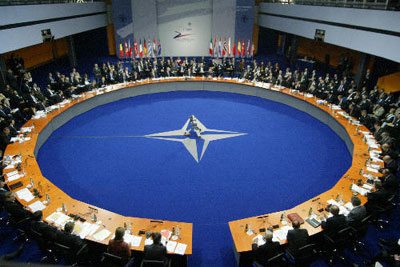In an article published yesterday in the European edition of Politico, former Supreme Allied Commander of NATO, Admiral James Stavridis, USN (Ret.) attempts to make the case for a new NATO.
To freshen up the idea, Admiral Stavridis asks the reader to imagine NATO as a computer program. NATO Version 1.0 was the Cold War institution, focused on defending Western Europe from a Soviet/Warsaw Pact invasion and deterring escalation to nuclear war. This basic program worked rather well for more than forty years, largely because its purpose remained clear, its missions relatively straightforward and the designers were careful not to add too many subroutines to the basic structure.
With the end of the Cold War, Alliance leaders thought that the institution might come in handy at a future time, so they looked around for a new rationale for the organization and new missions it might pursue while waiting to once again be called into action. This was NATO 2.0. The new program was much more complex than its predecessor, being required to simultaneously address the rapid expansion in its membership, new missions outside the physical borders of the Alliance, massive military downsizing, the explosion in IT-enabled military technology and a new, and for a time hopeful, relationship with Russia.
Now, Admiral Stavridis is proposing yet another version of the software, NATO 3.0. As described, this would be the most complex software upgrade yet. The new NATO must address five central tasks: cyber conflict, fighting the Islamic State in the Middle East, deterring Russia (but without igniting a new arms race), conducting an expanded anti-piracy campaign around the African continent and continuing to conduct military support and training activities in Afghanistan.
If Admiral Stavridis’s vision of NATO 3.0 were a computer program it would most closely resemble Microsoft Windows Millennium, voted one of the five worst tech products of all time by PC World. In fact, Millennium was just one of a number of disastrous attempts to improve Microsoft’s operating system. Anyone remember OS/2 or Bob? For a while, Microsoft had a reputation of publishing new versions of its operating system, each of which was larger and more complex than its predecessor without providing much additional value, something known as bloatware, but definitely slowing the system down. While new and useful features were often included in these software upgrades, they sometimes lacked adequate integration and testing.
NATO 3.0 is not just a software upgrade. It is a completely new program. It must simultaneously address new enemies, like the Islamic State, deter an old adversary conducting a new type of warfare, incorporate an entirely new conflict domain, cyber space and continue to perform current missions. It must do all this while continuing to lose resources.
Moreover, NATO cannot get to version 3.0 simply by adding on software routines. In fact, NATOs fundamental problem isn’t with its software but its hardware. The Alliance isn’t governed by Moore’s law with the power of its processors doubling every 18 months. Its capabilities have been declining since the end of the Cold War, particularly in those areas associated with mid-to-high end conflicts. The Alliance took a twenty year holiday from defense spending and what money it did have for defense it tended to spend inefficiently. Faced with continuing economic woes, a number of NATO countries are cutting their defense budgets even as threats to their security proliferate. To put it in computerese, the Alliance has run out of the RAM to handle the proposed new software upgrade.
Last year, the Lexington Institute published a study that identified steps the Alliance could take to meet emerging challenges and avoid strategic irrelevance. The study concluded that NATO needed to do less, not more, but to do those critical tasks better. NATO forces needed to shrink and the resources harvested to fill existing capability gaps. It proposed that the Alliance either fix the NATO Response Force or disband it. This is precisely what NATO is attempting to do with the creation of its new rapid response force. NATO needs to invest in critical capabilities including ISR, cyber, airlift, logistics and advanced weapons.
No operating system or software program can do everything. Neither can the Alliance. If there is a NATO 3.0 it needs to be a simpler system, focused on the critical task of protecting its members from aggression. The more you burden the basic operating system with additional features and functions, the greater the likelihood that your computer will crash. As proposed, NATO 3.0 is likely to crash the Alliance.










